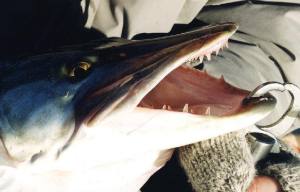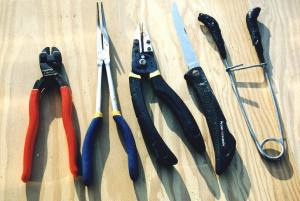WATCH THOSE FINGERS; HOOKS AND TEETH CAN HURT!
by
Steve Wickens

It only takes a quick peak into the mouth of a good-sized pike or muskie to quickly
surmise that this is not a wise place to stick your digits if you wish for them to remain
intact. Those spike-like teeth on the roof of their mouth can shred your knuckles in the
blink of an eye, while the larger lower teeth can really do some serious damage. Trophy
sized specimens may have teeth approaching two centimetres (3/4 inch) long, and should be
shown extreme caution.
But even more dangerous than teeth are loose treble hooks. Finding a large treble hook
buried in your arm or hand is bad enough, but becomes a pretty frightening situation if
the other end of that bait is still attached to an active pike or muskie. Muskie legend
Dick Pearson, found himself in that very situation many years ago. The fish ripped the
lure out of the back of Dick's hand, resulting in a requirement for sixteen stitches.
Another fellow guide took a barb right up under a knuckle. He was fishing alone at the
time. Luckily he had a compound cutting tool nearby and was able to cut himself out of
trouble, but still required emergency surgery on his finger to remove the hook and save
the finger.
Whether you are experienced or not, hand landing pike or muskies is extremely dangerous
when lures with multiple treble hooks are being used, and even more so once the lures
exceed six or seven inches in length. Fish should be landed using one of the following
methods: release gaff, net, cradle, or lipping tool (such as a Boga Grip). I should point
out that the cradle is a two-man operation. The release gaff is the most difficult to
learn, and requires confidence, and patience. The easiest to use to learn, and also one of
the most effective is a net. The bigger and heavier the hoop and yoke, the better the net.
Frabill and Beckman manufacture the best nets, but Lucky Strike and Gibbs also make some
good products. A net with a rubberized mesh is superior to traditional mesh, as it removes
less of the protective slime from the fish, and is also less susceptible to tangling. Pick
a landing tool, and get good with it. If you are not sure how to use any one of these
release methods properly, organizations like Muskies Canada or Pikemasters would be only
to happy to help you out.
Once the fish is contained, then the hooks should be removed as quickly as possible. Try
to keep the fish in the water as much as possible if the fish is to be released. More than
two minutes out of the water, and that fish will not survive. For smaller hooks, a
long-handled hook disgorger like the Baker Hook-out, or a pair of long-handled 45-degree
offset pliers will work fine. For bigger hooks, you will want a pair of heavy Stanley or
Vise Grip pliers. Deeply buried hooks, or hooks in around the gills should be cut-off as
short as possible. A compound cutter makes this job easy. Knipex makes the best cutters on
the market for this; their cutters will cut a huge 9/0 stainless hook with one-hand.
Compound cutters are a must for the safety reasons I noted above too. In the event you get
hooked, you're only going to have one hand free; side cutters just won't do the job on
larger hooks! A pair of jaw spreaders is a handy tool that gives you a little more
clearance around those teeth. Wrap some hockey or electrical tape around the ends to
prevent the sharp ends from damaging the soft tissue, and to add a little extra clearance.
A sharp fillet knife is also handy. Sometimes simply knicking the flesh where a barb is
hung-up can make hook extraction possible.
Let your tools do the work, and watch those teeth and hooks. Once the hooks are out, get
the lure out of the way. Now you're free to handle the fish for a photo or release it. Try
to handle pike and muskies by lifting them horizontally rather than vertically, as this
places much less stress on the spine and internal organs of the fish. Fish should never be
held vertically on a gaff or lipping tool, as there is a high likelihood that the jaw
could be dislocated or broken. Be very mindful of the out of water time. The gills cannot
be out of the water for longer than one or two minutes! The hotter the air temperature,
the more stress the fish will endure when it is handled, and the less time it will take
for permanent gill damage to result from being left out of the water too long.
Most of us like the odd picture when a good fish comes aboard, especially if we are going
to be releasing the fish. Despite what you might occasionally see in some magazines,
holding a fish up with a lure dangling from its mouth is an accident looking for a place
to happen. Don't do it! Cradle the fish horizontally while your buddy snaps a few quick
photos, and then get that fish back in the water quickly.
Muskies and northern pike both are impacted by lactic acid. Lactic acid builds in the
bloodstream when the fish is subjected to undue stress. This build-up makes it difficult
for these fish to properly absorb oxygen into the blood. A severe build-up of lactic acid
can actually cause a pike or muskie to succumb to delayed mortality hours after what might
appear as a successful release. This is why it is very important to keep handling and out
of water time to minimum to reduce stress.
In the event you get bit, apply pressure to stop the bleeding, and wash the area
thoroughly when you get home to eliminate any chance of infection. If you get hooked, the
most important thing you can do is to subdue the fish, and get to those compound cutters
and cut the hooks free just as quickly as you can. A thrashing fish can do to considerable
damage in a matter of seconds… damage that could end your fishing season, or even
leave you with a permanent handicap. Don't take chances, and always be on your guard when
your hands are anywhere near the business end of a pike or muskie. Make sure your tools
are handy, and in good working condition. Seized-up pliers or cutters are of little value.
Oil your tools periodically throughout the season, and check them. A safe trip is also
more likely to be a happy trip!

Muskies and pike have nasty teeth, don't take chances!
The right tools for the job (L to R): compound cutters, offset pliers,
heavy pliers, knife, and jaw-spreaders.
STRIKE ZONE Muskie Charters http://www3.sympatico.ca/strike.zone
Muskie charters in the Kawarthas. Over 20 years of muskie angling experience, with
close to 1,000 lifetime muskies boated, and 5 years as a professional guide. Uses a
variety of innovative tactics and strategies for this remarkable fish. Writes regularly
for a number of major fishing magazines/Internet sites, does lectures & seminars, and
TV/radio. A long-time member of Muskies Canada, the Kawartha Fisheries Association, and
the Outdoor Writers of Canada. Steve Wickens strike.zone@sympatico.ca
|